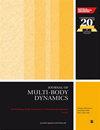考虑振动误差和润滑的直升机中间减速器螺旋锥齿轮动力学行为分析
IF 1.9
4区 工程技术
Q3 ENGINEERING, MECHANICAL
Proceedings of the Institution of Mechanical Engineers Part K-Journal of Multi-Body Dynamics
Pub Date : 2022-05-04
DOI:10.1177/14644193221093214
引用次数: 0
摘要
在螺旋锥齿轮动力学仿真中,齿轮的建模和接触分析非常复杂;因此,对SBG进行动态分析通常会简化SBG模型。啮合过程中的振动会引起啮合轨迹偏离,导致啮合刚度、油膜厚度和齿间负载分布的变化。这些变化不能用简化的模型来实现。为了准确计算直升机中间减速器SBG副在振动位移影响下的动力学行为,基于有限元法和齿轮啮合原理,对SBG进行了含误差的载荷-齿接触分析。提出了一种考虑误差和弹流润滑因素的啮合刚度计算方法。为建立尾驱薄壁轴Timoshenko梁单元和SBG集总质量法的耦合非线性动力学模型,应用Newmark共轭梯度法。得到了振动位移、啮合轨迹、齿侧间隙、油膜厚度和啮合刚度等参数的变化。结果表明,考虑油膜刚度后的接触刚度比不考虑油膜影响的接触刚度降低了17.7%,并且由于耦合模型考虑了时变系统的振动影响,油膜刚度波动更大,幅值比商业软件增加了18.5%。耦合动力学模型计算了动态啮合力、法向相对位移、单齿啮合周期和油膜厚度,发现相关参数的幅值增大。所得的时变润滑参数为研究传动系统在失去润滑作用下的演化提供了理论依据。本文章由计算机程序翻译,如有差异,请以英文原文为准。
Dynamic behavior analysis of spiral bevel gears of helicopter’s intermediate reducer with vibration error and lubrication
In the dynamic simulation of spiral bevel gears (SBGs), the modeling and contact analysis of the SBGs are extremely complicated; therefore, dynamic analysis of the SBGs generally simplifies the SBG model. The vibration in the meshing process will cause the meshing trajectory to deviate, resulting in changes in the meshing stiffness, oil film thickness, and load distribution between teeth. These changes cannot be realized using simplified models. To accurately calculate the dynamic behavior of the SBG pair of the intermediate reducer of a helicopter under the influence of vibration displacement, a load-tooth contact analysis(LTCA) of the SBG with error was performed based on the finite element method(FEM) and gear meshing principle. A calculation method for the meshing stiffness, considering the errors and elastohydrodynamic lubrication (EHL) factors, is proposed. To establish the coupling nonlinear dynamic model of the tail drive thin-walled shaft Timoshenko beam element and SBG lumped mass methods, applied the Newmark conjugate gradient method. Changes in parameters such as vibration displacement, meshing trajectory, tooth side clearance, oil film thickness, and meshing stiffness were obtained. The results show that the contact stiffness after considering the oil film stiffness is reduced by 17.7% compared to that without considering the effect of the oil film, and the oil film stiffness fluctuates more because the coupled model takes into account the vibration effect of the time-varying system, and the amplitude increases by 18.5% compared to the commercial software. The coupled kinetic model calculates the dynamic meshing force, normal relative displacement, single tooth meshing period and oil film thickness, and finds that the amplitude of the relevant parameters increases. The obtained time-varying lubrication parameters provide a theoretical basis for studying the evolution of the transmission system under the loss of lubrication.
求助全文
通过发布文献求助,成功后即可免费获取论文全文。
去求助
来源期刊

CiteScore
4.10
自引率
11.10%
发文量
38
审稿时长
>12 weeks
期刊介绍:
The Journal of Multi-body Dynamics is a multi-disciplinary forum covering all aspects of mechanical design and dynamic analysis of multi-body systems. It is essential reading for academic and industrial research and development departments active in the mechanical design, monitoring and dynamic analysis of multi-body systems.
 求助内容:
求助内容: 应助结果提醒方式:
应助结果提醒方式:


